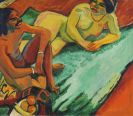
Camille Claudel
1864 Frère-en-Tardenois, Frankreich
1943 Montdevergues, Frankreich
Camille Claudel was born on December 8, 1864 in Fère-en-Tardenois in Campagne and is regarded as one of the most important artists of modern sculpture. Many years before her death, her works of sculpture had already almost been forgotten and ignored by the scholarship. The artist and sister of well-known writer Paul Claudel spent the last 30 years of her life in the sanatorium of Montdevergues in Vaucluse. Her works of art and moving life story were only rediscovered in recent years.
Camille Claudel already began modeling with clay in her early years. Family, friends, and even employees served as models. In a chance encounter with the French sculptor Alfred Boucher (1850-1934), she found a sponsor for her sculpting and her wish for an artistic education in Paris. In 1881, the mother Louise-Anthanaïse Claudel moved to Paris with her three children Camille, Louise (1866), and Paul (1868).
Camille attended drawing and anatomy courses at the private art academy "Académie Colarossi" because women were only allowed to study at the Parisian Art Academy after 1897. Camille Claudel shared a studio with the other women students, which Alfred Boucher visited on a regular basis to monitor their progress. She created mostly portrait busts during this time, including one of her brother Paul and the well-known bust "La vielle Hélène".
Alfred Boucher asked his friend, the sculptor Auguste Rodin, to assume the monitoring at the studio of the art students around Camille Claudel in 1883. Claudel and Rodin met here for the first time and he recognized her extraordinary talent. During that same year, she participated for the first time in the exhibition at the salon of the "Société des Artistes Français" (S.A.F.). A year later, Rodin created the first of several portraits of Camille and she began to work more with whole figures.
Beginning in 1885, Camille Claudel worked with her friend Jessie Lipscop in Rodin’s studio and became his muse and lover. In 1887, Rodin received the commission for the memorial "The Burghers of Calais", in which Claudel’s participation was especially decisive for the modeling of the hands and feet. She was also responsible for the transposition of the master’s figures into marble at Rodin’s studio.
She developed outstanding competence in stone workmanship as a result. One year later, the artist couple moved into a mutual studio at the Clos-Payen Park. Claudel’s work concentrated increasingly on Rodin’s projects. Her complicated relationship with the artist finally prompted her to leave their mutual studio in 1892 in order to establish herself as an independent artist.
After the initial criticism of the Parisians, Camille Claudel decided to liberate herself and to find a new method of depicting the human being. She created the works "La Valse" (1893) and "Clotho" (1893). In 1895, the artist received her first government commission from the culture administration for a plaster version of the major composition "L`Age mûr".
After two years of distance, she began to intensify her contact with Auguste Rodin again. As a result of his sponsorship, she once again became entangled in both an artistic and a financial dependency. But a final break between the two occurred because of the intrinsic outside pressures upon her as a woman and an artist, as well as the beginning of Rodin’s interventions against her work - especially the "L`Age mûr". In her work "L`Age mûr", which is understood to be autobiographical, she presumably processed her complex romantic relationship and her inner conflict.
Around 1900, she moved into the last studio of her own on Île Saint-Louis and participated in the world fair in Paris that same year with three sculptures. Rodin simultaneously presented a cross-section of his works in his own pavilion. Camille Claudel’s works after 1900 are characterized by their conformation to the contemporary audience’s taste and her financial situation. The artist increasingly lost her courage and strength to fight the contradictions that were both outside and within her.
Her family had never been able to accept her lifestyle and was also not supportive now. Instead, her brother Paul -with whom she had maintained regular correspondence - decided to commit her to a psychiatric institution in Ville-Évard in 1913.
Because of the wartime situation, Camille Claudel eventually came to the Montdevergues sanatorium, where Camille Claudel remained until the end of her life on October 19, 1943.

Would you like to sell a work by Camille Claudel?
Infos for sellerART MARKET:

Oil on canvas, painted on both sides, 1910
Estimated price 2.000.000
More offers >






